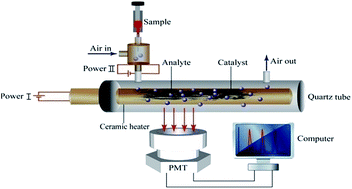A sensitive cataluminescence-based sensor using a SrCO3/graphene composite for n-propanol
Abstract
In this paper, we developed a cataluminescence-based sensor using SrCO3/graphene for sensitive and selective detection of n-propanol. The composite was characterized by X-ray diffraction, transmission electron microscopy, Fourier transform infrared spectroscopy, and gas adsorption. The sensor was coupled with a miniature vaporizing device to detect n-propanol in liquid samples. The experimental results revealed that the SrCO3/graphene sensor exhibited a sensitivity for n-propanol 5.8 times higher than that of pure SrCO3, indicating that the sensitivity of the SrCO3/graphene sensor was increased by adding graphene to SrCO3. The linear range of the sensor was 0.2 to 32 mg L−1 (r = 0.9987) with a limit of detection of 0.08 mg L−1. The sensor showed a rapid response of 2 s and a recovery time of 20 s, respectively. The sensor was used to analyze samples spiked with known concentrations of n-propanol. The concentrations of n-propanol in all samples were well quantified with satisfactory recoveries, indicating that the SrCO3/graphene sensor is a promising candidate for fast, sensitive, selective detection of n-propanol. We also discuss the possible mechanism based on the reaction products.


 Please wait while we load your content...
Please wait while we load your content...